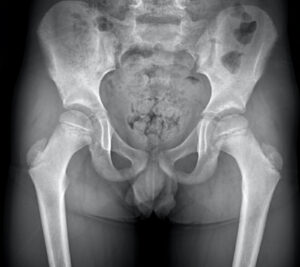Hip Disorders
What causes hip dysplasia ?
 The hip joint is a ball-and-socket structure that connects the femur to the pelvis. The femoral head (top of the femur) does not line up properly with the curved socket in the pelvis in persons with hip dysplasia. In rare circumstances, the socket is insufficiently deep to retain the femoral head in place.
The majority of patients with hip dysplasia were born with the disorder. Hip dysplasia can occur when the baby’s position in the womb places pressure on the hips. It might also be inherited (passed down in families).
The hip joint is a ball-and-socket structure that connects the femur to the pelvis. The femoral head (top of the femur) does not line up properly with the curved socket in the pelvis in persons with hip dysplasia. In rare circumstances, the socket is insufficiently deep to retain the femoral head in place.
The majority of patients with hip dysplasia were born with the disorder. Hip dysplasia can occur when the baby’s position in the womb places pressure on the hips. It might also be inherited (passed down in families).When this issue is present at birth, it is referred to as developmental dysplasia of the hip or congenital hip dislocation.
The following are signs and symptoms of hip disorder:
Hip discomfort
Hip joint that is loose or unstable
Walking with a limp Leg length disparities
hip disorder diagnosed
In the first few days of a baby’s existence, the doctor will undertake a physical exam to screen for hip dysplasia, and then again after around two months. It is possible that symptoms of the illness will not appear until a kid is older.
In children above the age of six months, X-rays, ultrasonography, and CT scans can be used to confirm a diagnosis. Doctors can use these tests to view inside the hip joint to identify abnormalities and search for symptoms of injury.
hip disorder treatement
Hip dysplasia treatment focuses on reducing discomfort and preserving the hip joint from future injury. The therapy will be tailored to the patient’s unique needs by the doctor.
Hip dysplasia treatment options include:
Brace: For newborns under 6 months old, a brace or harness may be used to keep the joint in position as the kid grows.
Exercises can help to strengthen the joint and increase flexibility (ability to move the joint).
In many situations, physicians restore the hip joint with procedures such as arthroscopy.

